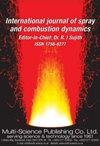Low-order modeling of high-altitude relight of jet engine combustors
IF 2.1
4区 工程技术
Q3 ENGINEERING, MECHANICAL
International Journal of Spray and Combustion Dynamics
Pub Date : 2021-06-01
DOI:10.1177/17568277211021322
引用次数: 7
Abstract
A physics-based, low-order ignition model is used to assess the ignition performance of a kerosene-fueled gas-turbine combustor under high-altitude relight conditions. The ignition model used in this study is based on the motion of virtual flame particles and their extinction according to a Karlovitz number criterion, and a stochastic procedure is used to account for the effects of spray polydispersity on the flame’s extinction behavior. The effects of large droplets arising from poor fuel atomization at sub-idle conditions are then investigated in the context of the model parameters and the combustor’s ignition behavior. For that, a Reynolds-averaged Navier-Stokes simulation of the cold flow in the combustor was performed and used as an input for the ignition model. Ignition was possible with a Sauter mean diameter (SMD) of 50 μm, and was enhanced by increasing the spark volume. Although doubling the spark volume at larger SMDs (75 and 100 μm) resulted in the suppression of short-mode failure events, ignition was not achieved due to a reduction of the effective flammable volume in the combustor. Overall, a lower ignition probability is obtained when using the stochastic procedure for the spray, which is to be expected due to the additional detrimental effects associated with poor spray atomisation and high polydispersity.喷气发动机燃烧室高空点火的低阶建模
采用一种基于物理的低阶点火模型,对高空光照条件下煤油燃气轮机燃烧室的点火性能进行了评估。本文所采用的点火模型是基于虚拟火焰粒子的运动及其熄灭,根据Karlovitz数准则,并采用随机过程来考虑喷雾多分散性对火焰熄灭行为的影响。然后在模型参数和燃烧室点火行为的背景下,研究了亚怠速条件下燃料雾化不良引起的大液滴的影响。为此,对燃烧室中的冷流进行了reynolds -average Navier-Stokes模拟,并将其用作点火模型的输入。当SMD直径为50 μm时,可以实现点火,并通过增加火花体积来增强点火效果。虽然在较大的smd (75 μm和100 μm)上,火花体积增加了一倍,可以抑制短模故障事件,但由于燃烧室中有效可燃体积的减少,无法实现点火。总的来说,当使用随机程序进行喷雾时,可以获得较低的点火概率,这是可以预期的,因为与较差的喷雾雾化和高多分散性相关的额外有害影响。
本文章由计算机程序翻译,如有差异,请以英文原文为准。
求助全文
约1分钟内获得全文
求助全文
来源期刊

International Journal of Spray and Combustion Dynamics
THERMODYNAMICS-ENGINEERING, MECHANICAL
CiteScore
2.20
自引率
12.50%
发文量
21
审稿时长
>12 weeks
期刊介绍:
International Journal of Spray and Combustion Dynamics is a peer-reviewed open access journal on fundamental and applied research in combustion and spray dynamics. Fundamental topics include advances in understanding unsteady combustion, combustion instability and noise, flame-acoustic interaction and its active and passive control, duct acoustics...
 求助内容:
求助内容: 应助结果提醒方式:
应助结果提醒方式:


